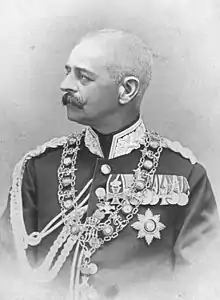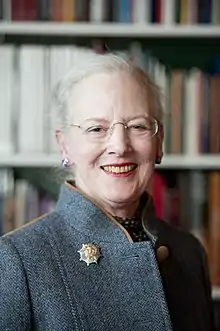House of Oldenburg
The House of Oldenburg is a European dynasty of North German/Danish origin. It is one of Europe's most influential royal houses, with branches that rule or have ruled in Denmark, Iceland, Greece, Norway, Russia, Sweden, Schleswig, Holstein, and Oldenburg. The current Queen of Denmark and King of Norway, the former King of Greece, the consort of the monarch of the United Kingdom, as well as the first fourteen persons in the line of succession to the British throne, are all patrilineal members of the Glücksburg branch of this house.
The dynasty rose to prominence when Count Christian I of Oldenburg was elected as King of Denmark in 1448, of Norway in 1450 and of Sweden in 1457. The house has occupied the Danish throne ever since.
History
Marriages of medieval counts of Oldenburg had paved the way for their heirs to become kings of various Scandinavian kingdoms. Through marriage with a descendant of King Valdemar I of Sweden and of King Eric IV of Denmark, a claim to Sweden and Denmark was staked, since 1350.
At that time, its competitors were the successors of Margaret I of Denmark. In the 15th century, the Oldenburg heir of that claim married Hedwig of Schauenburg, a descendant of Euphemia of Sweden and Norway and also a descendant of Eric V of Denmark and Abel of Denmark. Since descendants better situated in genealogical charts died out, their son Christian (the abovementioned) became the king of all three kingdoms of the whole Kalmar Union. The House of Mecklenburg was its chief competitor regarding the Northern thrones, and other aspirants included the Duke of Lauenburg. Different Oldenburgine branches have reigned in several countries. The House of Oldenburg was briefly poised to claim the British thrones through the marriage of Queen Anne and Prince George of Denmark and Norway; however, due to the early deaths of all their children, the crown passed to the House of Hanover.
Main line
- Kings of Denmark (1448–1863)
- Kings of Norway (1450–1814)
- Kings of Sweden (1457–64, 1497–1501 and 1520–21)
- Counts of Oldenburg (1101–1773)
- Dukes of Schleswig and Counts of Holstein (1460–1544)
- Dukes of Schleswig and Holstein, ruling only part of the Duchies (1544–1721/1773)
- Dukes of Schleswig (1721–1864, ruling the entire Duchy)
- Dukes of Holstein (1773–1864, ruling the entire Duchy)
Branches
- Schleswig-Holstein-Sonderburg-Augustenburg, extinct in male line in 1931
- Dukes of Schleswig-Holstein (claimant in 1863, then titular dukes until 1931)
- Schleswig-Holstein-Sonderburg-Glücksburg
- Dukes of Schleswig-Holstein (titular dukes since 1931)
- Kings and queens of Denmark (since 1863)
- King of Iceland (1918–44)
- Kings of the Hellenes (1863–1924, 1935–73)
- Mountbatten-Windsor line: although Prince Philip, Duke of Edinburgh, his children and his sons' children are patrilineally descended from this branch, his male-line descendants bearing the style of "Royal Highness" are de jure members of the House of Windsor, by declaration of the British monarch.[3]
- Kings of Norway (since 1905)
- Schleswig-Holstein-Gottorp
- Dukes of Holstein-Gottorp (1544–1739)
- Holstein-Gottorp-Romanov (commonly still called Romanov)
- Holstein-Gottorp (Swedish line), extinct
- Kings of Sweden (1751–1818)
- King of Norway (1814–18)
- Holstein-Gottorp (Grand ducal line)
- Dukes (later grand dukes) of Oldenburg (1774–1918)
Gallery
 The first Oldenburg king was Christian I of Denmark, Norway and Sweden (1426–1481)
The first Oldenburg king was Christian I of Denmark, Norway and Sweden (1426–1481) Sweden's most prominent Oldenburg king was Gustav III (1746–1792)
Sweden's most prominent Oldenburg king was Gustav III (1746–1792) Frederick Augustus II, Grand Duke of Oldenburg (1852–1931)
Frederick Augustus II, Grand Duke of Oldenburg (1852–1931) Nicholas II (1868–1918) was the last Emperor of Russia
Nicholas II (1868–1918) was the last Emperor of Russia Prince Philip, Duke of Edinburgh, Prince of Greece and Denmark (*1921)
Prince Philip, Duke of Edinburgh, Prince of Greece and Denmark (*1921).jpg.webp)
.jpg.webp) King Harald V of Norway (*1937)
King Harald V of Norway (*1937) Queen Sofía of Spain, Princess of Greece and Denmark (*1938)
Queen Sofía of Spain, Princess of Greece and Denmark (*1938) Queen Margrethe II of Denmark (*1940)
Queen Margrethe II of Denmark (*1940) Former King Constantine II (*1940) and Queen Anne-Marie (*1946) of Greece, both Oldenburgs, she being a princess of Denmark
Former King Constantine II (*1940) and Queen Anne-Marie (*1946) of Greece, both Oldenburgs, she being a princess of Denmark Christoph, Prince of Schleswig-Holstein (*1949), head of the House of Oldenburg since 1980[4]
Christoph, Prince of Schleswig-Holstein (*1949), head of the House of Oldenburg since 1980[4]
See also
|
|
|
Footnotes
- Genealogisches Handbuch des Adels, Fürstliche Häuser, Band XVII, "Oldenburg". C.A. Starke Verlag, 2004, pp. 44-50 (in German). ISBN 9783798008335.
- Burke's Royal Families of the World, p. 60. ISBN 0-85011-023-8.
- Royal Styles and Titles – 1960 Letters Patent
- Genealogisches Handbuch des Adels, Fürstliche Häuser, Band XVI, "Haus Holstein". C.A. Starke Verlag, 2001, pp. 44-50 (in German). ISBN 3-7980-0824-8.
External links
 Media related to House of Oldenburg at Wikimedia Commons
Media related to House of Oldenburg at Wikimedia Commons- Marek, Miroslav, The House of Oldenburg, Genealogy.EU.
House of Oldenburg | ||
| Preceded by House of Romanov |
Imperial house of Russia 1762–1917 |
Vacant |
| Preceded by House of Wittelsbach |
Royal house of Greece 1863–1973 |
Monarchy abolished |
| Preceded by House of Palatinate-Neumarkt |
Royal house of Denmark 1448–present |
Present house (branch: Glücksburg) |
| Preceded by House of Bernadotte |
Royal house of Norway 1905–present | |
| Vacant Title last held by House of Bonde |
Royal house of Norway 1450–1818 |
Succeeded by House of Bernadotte |
| Royal house of Sweden 1457–1464 |
Vacant Title next held by House of Bonde | |
| Royal house of Sweden 1497–1501 |
Vacant | |
| Vacant | Royal house of Sweden 1520–1521 |
Vacant Title next held by House of Vasa |
| Preceded by House of Schaumburg |
Comital House of Holstein 1460–1474 |
County raised to duchy |
| Ducal house of Schleswig 1474–1864 |
Second Schleswig War | |
| County raised to duchy | Ducal House of Holstein 1474–1864 | |
| Vacant Title last held by House of Hanover |
Ducal House of Saxe-Lauenburg 1814–1864 |
Vacant Title next held by House of Hohenzollern |
